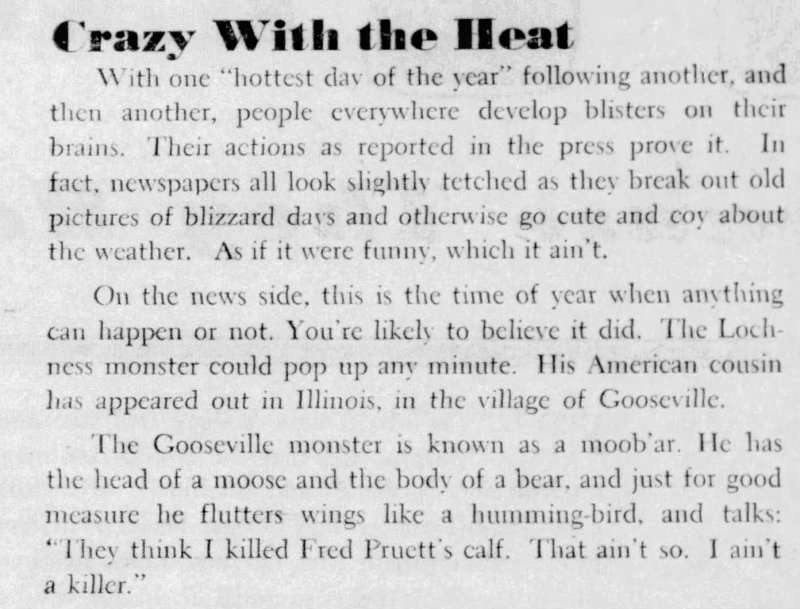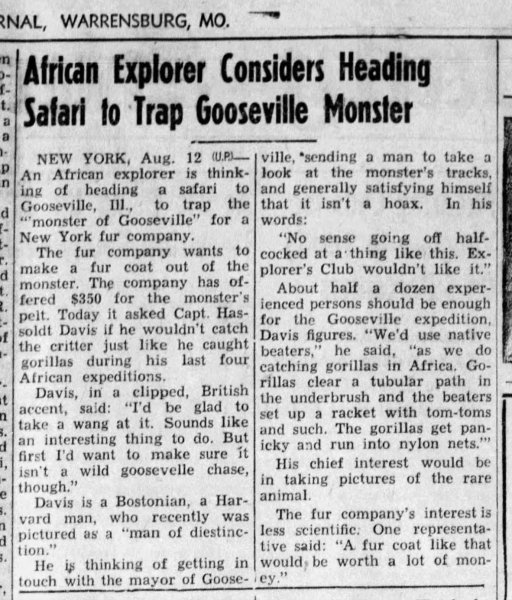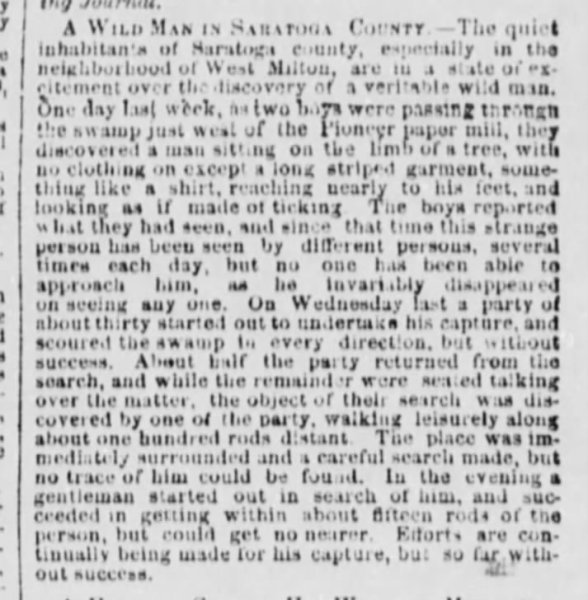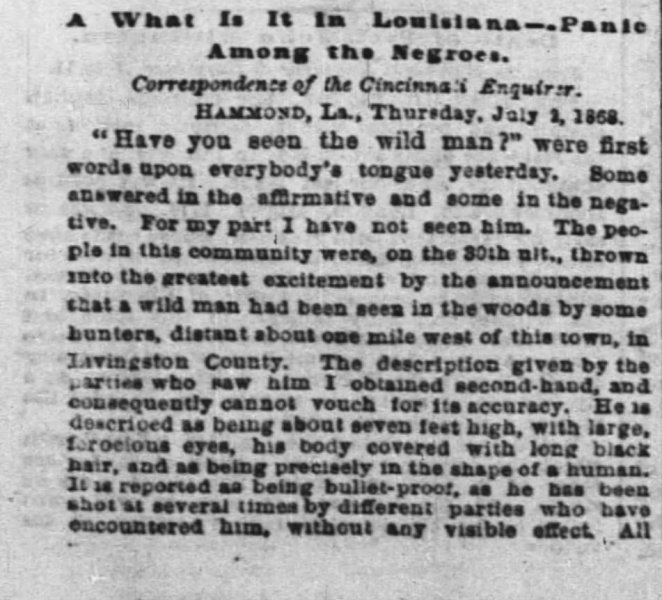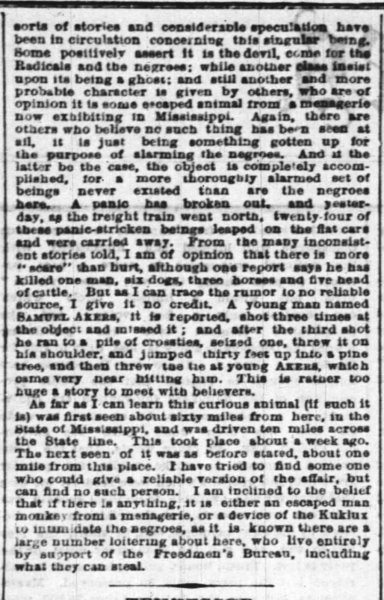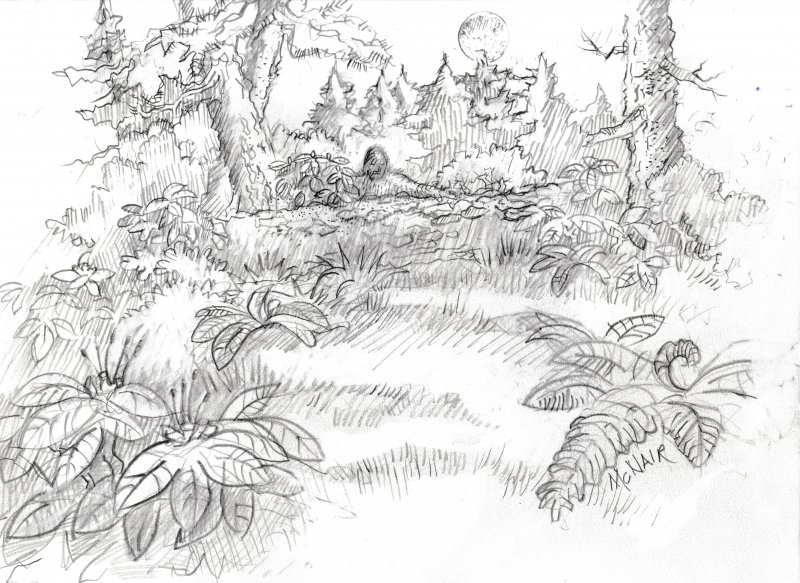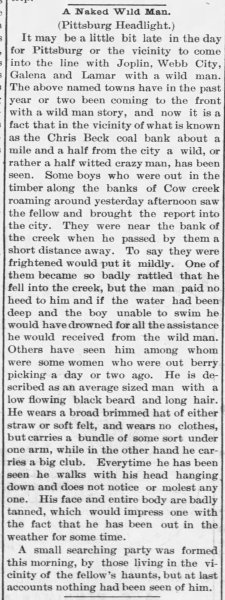All Activity
- Past hour
-
In addition to predator/omnivore, don't forget scavenger. I'm not talking "roadkill" (although that's surely part of it), but similar to brown bears (whose eating behaviors and food preferences differ from black bears). Among the first spring meals they seek out are winter kills, which are more numerous than most folks think. An example, beyond starved ungulates, are sheep, goats, and deer killed by avalanches. I remember a snow avalanche that killed a small herd of sheep on the Kenai Peninsula that attracted lots of brown bears the following spring. As a hunter, I read a lot of ADFG Management Reports. They do pay attention and even conduct studies on predator effects on ungulates, and this has grown exponentially as the environmental movement has put political pressure on predator management. But the effect of so few sasquatches is more than minimal compared to humans (hunters, car drivers, trains, poachers, etc), bears, wolves, and lions, so sasquatch predation can easily be swallowed up by the rest of the predators. https://www.adfg.alaska.gov/static/research/wildlife/speciesmanagementreports/pdfs/moose_2015_2025_smrp_gmu_14a.pdf I'm sure that the dead body/skeleton thing is primarily a thing regarding their rarity. For example, there are an estimated 30K-40K cougars and an estimated 60K-80K wolves in North America. Humans? 380 million in the US and Canada. Of those millions of people in North America, some 630K are reported as missing, although we know many of them are alive and want to be missing, or are held by others. Compare all that to an estimated 5K sasquatches. I've found skeletons in the woods. I Initially thought them as human (no skull) and called the Troopers. They turned out to be poached goat or sheep. I've found lots of moose and caribou skeletons or carcasses. Never bear or wolf...............or human. If someone found a sasquatch skeleton, including the skull, what are they most likely to do? My bet is that they'd either call the local police (thinking they're "human"), or they'd walk away. I doubt they'd call fish and feathers, the FBI, or another agency. And if the local police investigate, what are they likely to do if they come to realize that these remains are...............funny? My bet is that they'd contact................somebody else?
- Today
-
That is, admittedly, a puzzle. A couple friends have stumbled over human bodies. We generally don't leave our dead laying around but .. it does happen. It may be just a matter of very much lower population but .. it is a thing that causes ye olde "eyebrow of concern" to raise a bit. It is a question worthy of further consideration. This may sound like I'm reversing course .. I'm not .. but I think that while we're following the data we have to consider not eliminating possibilities which might not be best-fit from further consideration. Weight-of-data changes over time, sometimes only a little in ways that don't change the conclusions, other times very substantially requiring a total re-think. Similarly we should find more signs of feeding on plants / berries than we seem to see in the report data. Not giant gorilla-type swaths of destruction, but .. something. Maybe it is too subtle, maybe it's mixed with bear foraging in ways such that we just don't recognize the BF contribution as a separate thing. So .. I hope you observe that I'm as cautious about completely discarding potential conclusions as I am about prematurely embracing them .. even when the data seems to fit. So far as calories? The area I mostly research has a late summer berry crop which more or less coincides with the annual activity peak. I'm leery of drawing a conclusion about that because the same activity peak occurs the full length of the Cascades yet the berry crop does not match in timing once you are further north or south. Here, that activity seems to continue until mid October which is about the time the deer drop out of the high country and migrate .. unlike most of the Cascades where blacktails just drop in elevation to mostly stay below snowline, here they do that plus they take off and go another 30-150 miles beyond what's necessary, a more mule deer type pattern. Anyway, things drop off mid September, about the time ODFW says the deer begin to move down and out, and continue to happen but with decreasing frequency until about mid October when the migration is essentially done. Sounds like calories? Seems likely. But we have to continue to consider "maybe not" and think about what alternatives might also explain the pattern. There are seemingly through-the-winter reports here in the deer / elk wintering areas. There are also a few reports in the locations between summer and winter areas. These seem to represent BF travel corridors. Low elevation tight against the foot of the mountains. A few lower passes have reports. I note that there are similar reports from the foothills of the Rockies. Hanging by deer herds? Traveling through? I don't know. Probably won't ever live close enough to investigate first hand. (Apologies for rambling.) MIB
-
Very well stated and consistent will credible report data. I would also add that the young male I witnessed in 2009 was carrying a dead fawn that had been mostly picked over, I truly doubt the situation was anything like Tom Hanks and Wilson.
-

A Halloween visit to Georgia’s “monstrous" Bigfoot museum - FOX 5 Atlanta
BFFbot posted a topic in News Articles
A Halloween visit to Georgia’s “monstrous" Bigfoot museum FOX 5 AtlantaView the full article -
Georgia’s “monstrous" Bigfoot museum FOX 5 AtlantaView the full article
-
Illinois 1949 - African Explorer May Join Hunt - Tirademan!
Trogluddite posted a topic in More Historical Newspaper Archives
Published in the Warrensburg (MO) Daily Star-Journal on August 12, 1949. Meanwhile, a sophisticated New York writer blamed the heat wave for giving people "blisters on the brain" and causing them to see the Gooseville Monster in a story published in the Melville (NY) Newsday on August 12, 1949. -
What happens when a seasoned hunter from California sees something impossible just after sunrise — a massive black figure walking smoothly through 7-foot brush in the Sierra Nevadas, only to vanish before his eyes? In this gripping episode, we hear from Jordan, a 37-year-old outdoorsman whose years of archery hunting took a shocking turn. He recounts not only his initial visual encounter with what may have been a Sasquatch, but also bone-chilling screams in the middle of the night and a mysterious fleet of black government SUVs appearing days later. You’ll hear about the golden hour sighting, robotic movements, high-step walking through thorns, and trees violently swaying with no wind. This isn’t just another story — it’s a revelation that sent Jordan on a deep dive into the world of Sasquatch. Buckle up for “Revenge of the Sierra Sasquatch.” 🗣️ Share Your Story Had a Bigfoot encounter or strange experience? Send it to bigfootsociety@gmail.com – your story might be featured on the show! 🎥 Watch & Subscribe on YouTube 🔴 Subscribe here → Bigfoot Society YouTube 💬 Leave a comment & let us know your thoughts! 📞 Leave a voicemail with your story → Speakpipe (Use multiple voicemails if needed) 👥 Share this episode → Watch & Share 🎧 More episodes → Podcast Playlist 🌲 Recommended: New Jersey Bigfoot Encounters 💥 Support the Show & Get Perks ✅ Join the community on Supercast – Become a Member ✅ Listen ad-free & early on YouTube – Join Here 📱 Let’s Connect Instagram: @bigfootsocietyTwitter: @bigfoot_societyTikTok: @bigfoot.society🧰 Tools & Partners I Use (Affiliate Links) These help support the show at no extra cost to you: Beam (Better Sleep): Try BeamWildgrain (Better Bread): Join HereSeed (Probiotics): Get SeedMedi-Share (Healthcare): Learn MoreLMNT (Electrolytes) Free Sample Pack with your first purchase! : Get LMNTOrganic and non-GMO groceries delivered for less http://thrv.me/uarEhS🎙️ Podcasting Tools: Repurpose.io: Try ItDescript: Sign UpStreamyard: Start RecordingRiverside.fm: Try Riverside🎧 My Audio Interface: View on Amazon ☕ Buy Me a Coffee – Support Here 🛍️ Grab Some Merch – Shop on Etsy 📬 Mailing Address: Bigfoot Society 125 E 1st St. #233 Earlham, IA 50072Listen to the Podcast
-
Agreed. If it’s primarily an herbivore then winter becomes a very hard sell. Yes. The coast of the Pacific NW is typically devoid of snow. But most of the northern U.S. and Canada where many reports come from have a real winter. That’s a problem for a primate herbivore IMHO. So unless they all migrate into a tiny area along the ocean, they must eat meat. But we don't know what we don’t know, but they don’t discover black holes by looking for them. You cannot observe a black hole. But what you can do is observe the effects of a black hole on the stars and planets around it. If Bigfoot is primarily a predator? Then its effects on ungulate populations that we track MUST be in the data. I really liked the bone study that BTW was doing. Hope all is well with him.
-
Gimlin talked about how massive and muscular Party was which goes along with this point. It just makes since Bigfoot would kinda have to be. Seems like a requirement to exist in the first place in such an environment. Makes sense to me. I’ve seen some of these scientists on Bigfoot shows limit Bigfoot to plants. I think they do that as cover to try to put their thumb on the scale against considering Bigfoot might be possible. Well, possible in that available food supply shouldn’t be an issue against Bigfoot. If Bigfoot can’t eat meat they think it’s harder to make the case there would be enough food to support Bigfoot. One fish = hours of scrounging-plants-on-the-full-belly standard. nature is supposed to favor efficiency. the guessing is getting better now that Bigfoot has moved from the Peter Graves “Monsters and myths” type of presentation and more into the Jeff Meldrum level discussions on TV. It’s a bit like the “ why don’t we find a body when they die” topic. At least they address it by logic and compassion to know animals life cycle
-
People who argue that are arguing from "religion", not report data. The report data, taken as a whole, is very clear. Taking the next step, the body shape reports are indicative of something that is primarily a predator. BF seldom if ever is described as having a big sloppy gorilla style gut needed for digesting masses of vegetation, they're described as having ripped abs .. ripped abs are not an herbivore characteristic. I think that just as black bears are omnivores that are primarily herbivorous but will opportunistically scavenge or even prey, bigfoot is technically an omnivore but primarily a predator, one that will not pass up a berry crop if handy. I suspect this is consistent .. maybe necessary .. for the large distances reportedly traveled. If you spend 16 hours a day chowing on weeds that's not much time left for walking, but if you can meet your nutritional needs in 15-30 minutes catching and consuming meat, there are many more hours available for travel .. or whatever else is available. Moreover, that reduced time spent foraging also means reduced time distracted and at risk of being seen. So we don't KNOW .. but like linear approximations in math, we can get within almost any distance from exact that we want to. And .. from those approximations we can devise tests, devise questions for study. Like .. science .. at least in a sort of loose hinged way. I think loose-hinged is fine, we have to remember we're still in discovery mode, not study mode.
-
Godspeed. May it lead to a PGF 2.0 or better by you or someone.
-
Whatever use you or anyone can make of Bigfoot's diet is fine by me. The more we know the more likely we can use it to come across Bigfoot. Since people still argue if Bigfoot eats meat or not that tells us we don’t know what bigfoots diet consists of. Sure if someone saw Bigfoot eating an apple they could assume Bigfoot likes apples. It doesn’t mean he doesn’t eat fish. It really doesn’t mean he prefers apples. Based on the report I would gladly put apples by a trail camera. Hopefully Bigfoot would get to them before 100 other animals or insects did. As far as defining encounter, I’d define it in the most of us do. To put it in a general way an encounter is the Goal. That is, seeing Bigfoot, filming Bigfoot, capturing Bigfoot, and for some shooting Bigfoot.
- Yesterday
-
New York 1868 - A Wild Man Near West Milton
Trogluddite posted a topic in More Historical Newspaper Archives
And now for the rest of the story. This story is included in Bigfoot in New York and New England by Paul and Robert Bartholomew, however - they fail to mention some important particulars. This may be an innocent oversight, as I rarely find the exact newspaper clipping cited by someone else and many wild man stories are borrowed and truncated by other papers. This report from The Buffalo (NY) Daily Republic on June 1, 1868, provides details that make the wild man sound more like a man than beast. -

A Night of Squatching with Bigfoot Expert Robert Swain - The Arkansas Democrat-Gazette
BFFbot posted a topic in News Articles
A Night of Squatching with Bigfoot Expert Robert Swain The Arkansas Democrat-GazetteView the full article -
 A Night of Squatching with Bigfoot Expert Robert Swain Northwest Arkansas Democrat-GazetteView the full article
A Night of Squatching with Bigfoot Expert Robert Swain Northwest Arkansas Democrat-GazetteView the full article -
That’s why I am looking at it. 👍
-
You're probably going to start thinking I'm picking on you .. I'm not trying to. a) you have to ask "useless to whom?" b) who gets to define "encounter"? I absolutely look at food availability, location, season, type, effort to extract, etc. when I think about looking for bigfoot. It's far from the only factor but it does have to be consistent with the rest. Where there isn't food enough, then we're looking at travel rather than occupancy.
-
 Explore the dark lore of Tennessee. Big Foot, Bell Witch among state's monsters, legends The TennesseanView the full article
Explore the dark lore of Tennessee. Big Foot, Bell Witch among state's monsters, legends The TennesseanView the full article -
2009 - Interview - B. Gimlin by HOLDMYBEER
Trogluddite posted a topic in Patterson-Gimlin Film Reference Materials
Forum member HOLDMYBEER has been fortunate enough to meet Bob Gimlin in person and to interview him on a few occasions. He has again permitted me to post his interview notes from his 2009 interview in this section. -
Louisiana 1868 - 7-Foot Tall Wild Man in Livingston County
Trogluddite posted a topic in More Historical Newspaper Archives
Published in The New York (NY) Times on July 13, 1868. The article claims that the wild man came from Mississippi and, sure enough, there is a story published in The Buffalo (NY) Daily Republic about the Mississippi wild man on June 1, 1868, a full month earlier. -
Hello Big Tex and thank you for the reply. Wow, you have been on the Bigfoot Trail for a long time ever since your experience when you're very young. It seems like that's all it takes to get interested in Bigfoot is one good experience, and you're set for life researching and studying this creature. I live in a town of about 20,000 people called Coos Bay Oregon and south of here is a road called the Seven Devils road. This was a term used by the early pioneers who found this area to be inhabited by the Bigfoots. I was out there just the other day and was hiking along one of the trails that goes through this area that is covered by dense brush and pine trees that make the forest so thick you can only see in it about 20 feet. I was a little leery about going too far into this area because you never know if the bigfoots are friendly or just shy and hide from any human activity. Not too far from this area is the county dump and a rumor has been circulating that the Bigfoots go up this creek canyon along the trails that I was on, and they go into the dump and scavenge for food.
-
Not necessarily. For example, I'm a bear hunter, but I rarely shoot them. My wife doesn't want me to, and I've grown to appreciate just watching them with optics. I enjoy just knowing as much about them as I can, but especially experiencing them personally in the wild with the rest of God's Creation all around. As I type, I recall watching a sow bear walking up a huge, old landslide on the opposite side of the Chulitna River from me as I was glassing during a moose hunt. As I recall the experience, I can clearly remember the strong breeze blowing up the river valley, the daily view of Denali nearby, and the giant boar bear prints that we find near camp as we left at the end of hunt. That old boar walked around our camp the evening before we left and left great prints in the mud of the trail for a couple miles. I took pics of a really good rear print. It was a foot long. A few days later, recounting the experience at work, another guy who had hunted that valley (and had shot a very interesting grizzly, which had a smashed face) told he he had seen that bear with his binoculars the year before. He was likely a 9 footer. Yeah, "an encounter" can mean different things to different people......................
-
I believe that the limited like evidence can be safe food for inference, but not solid enough to establish behavior. In the two examples I used above (Sunnyslope and Bossburg), both were in mid-winter, both were in central or east Washington (on the east side of the Cascades, and thus not in the coast range), and both left a long trackway (miles). As Nathan correctly clarified about my post on sasquatches in the Coast Range moving towards beaches to utilize beach foods, this is not likely at all of sasquatches in mountain ranges east of the Coast Range, like the Rockies, Blues, Cascades (south of the Columbia River), Sierra Nevada, etc (although sightings and trackways found in California's Central Valley in winter even infers that they might migrate to the Coast Range from the Sierras, or vice versa, on occasion). Peter Byrne once found a trackway in snow. I forget where regionally. He followed them through difficult terrain for miles. I don't think he theorized a general direction or motivation for the travel. The most notable thing I remember about his account was, at one point, the tracks walked atop a large fallen log covered in snow, and then the track maker jumped several feet to another snow covered fallen log. He was impressed, writing that such a jump was not possible by a hoaxer. What I find disappointing about his account is that his report on it, from his personal experience, is recorded in one of his books, but otherwise is lost to a queryable database search so that it might be available to help alleviate one of your recognized disclaimers (small sample size).....................
-
Ghosts and Bigfoot in Haliburton Forest thehighlander.caView the full article
-
Wild Humans (and Journalists) Running Wild
Trogluddite replied to Trogluddite's topic in More Historical Newspaper Archives
Kansas 1896, as published in the Fort Scott (KS) Daily Tribune and Fort Scott Daily Monitor on July 10, 1896. This appears to clearly be a human, but I wouldn't be surprised if a truncated form of this story shows up in a book or on a website and leaves out the part about "Bigfoot" wearing a straw hat and being tanned. (I have a good example of a book leaving out the smoking gun, but can't find it right now!)




